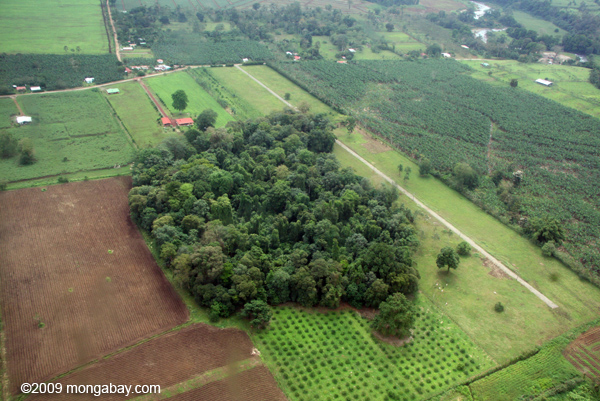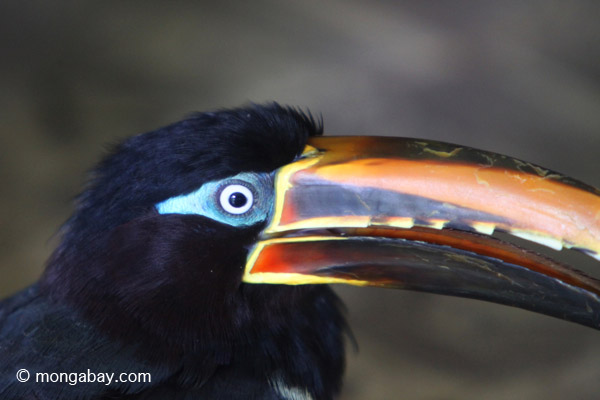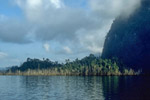Innovation in Tropical Forest Conservation: Q&A with Stuart Pimm
 Aerial view of forest fragment in Costa Rica. Photo by Rhett A. Butler.
Aerial view of forest fragment in Costa Rica. Photo by Rhett A. Butler.
Dr. Stuart Pimm is an expert in extinctions: why they happen, how fast they happen, and how they can be prevented. Reconnecting forest fragments and avoiding fragmentation, according to Pimm, are among the most crucial things we can do to conserve global biodiversity. His organization SavingSpecies identifies areas at-risk for extinctions and helps local organizations fundraise so they can protect and restore habitats and safeguard biodiversity.
Pimm worked and taught in Africa for nearly 20 years, concentrating on topics related to wildlife and ecosystem conservation. Though his work has been primarily with elephants, recently he has concentrated on the subject of lions through National Geographic’s Big Cats Initiative. His other research areas include the Everglades of Florida and tropical forests in South America, especially the Atlantic Coast forest of Brazil and the northern Andes, two of the world’s “hotspots” for threatened species.
Pimm is also the author of over 270 scientific papers and four books, and has won countless honors. The Institute of Scientific Information has ranked him as one of the most highly cited environmental scientists for the past decade. He is currently the Doris Duke Professor of Conservation Ecology at Duke University.
An Interview with Dr. Stuart Pimm

Stuart Pimm birding at sunset. Photo courtesy of Stuart Pimm.
Mongabay: What is your background?
Stuart Pimm: I started as a teenager, watching birds. That took me to Oxford, which had a famous ornithology group, to do my BSc degree. While there, I went on and then lead expeditions to Afghanistan and became fascinated with deserts. So I did my Ph.D on desert birds at New Mexico State University—a long way geographically and culturally from Oxford. I got a wonderful education there. Soon after getting my Ph.D, I went to Hawaii, almost by accident. There I began to see just how quickly species were becoming extinct. That was the start of my career as a conservation biologist and started my lifelong interest in tropical forests and their conservation.
Mongabay: How long have you worked in tropical forest conservation and in what geographies? What is the focus of your work?
Stuart Pimm: I started working in tropical forests in Hawaii, but have been working in Brazil (especially), Africa, and elsewhere in Latin America for 25 years. My main concerns are to understand the process of extinction—how fast is it, how many species are going extinct, where are they going extinct, and why and—especially—what we can do to prevent extinctions.
Mongabay: What do you see at the next big idea or emerging innovation in tropical forest conservation? And why?

Forest corridors in Costa Rica. Photo by: Rhett A. Butler.
Stuart Pimm: While some large blocks of tropical forest remain most is in highly fragmented landscapes. From our [SavingSpecies] work on islands and work we’ve done with Tom Lovejoy’s project in the Amazon on forest “islands” we know how quickly species are lost from forest fragments of different sizes. These studies quickly tell us that preventing forest fragmentation and reconnecting fragments is going to be a potent means of preventing extinctions.
Mongabay: What are the obstacles/challenges to reconnecting forest fragments?
Stuart Pimm: Most of the biodiversity hotspots—the places where most species are going extinct—are in fragments.
1. The first challenge is to identify the most cost-effective places for action.
2. One needs to identify good local NGOs who can implement restoration.
3. We have to raise the money for them!
Mongabay: How are these challenges being overcome?

Chestnut-eared aracari in Colombia. Photo by: Rhett A. Butler.
Stuart Pimm: The first of the two videos (see below) talks about for our project in Brazil. We’ve comparable science for our projects in Colombia and elsewhere.
Working with good local NGOs has been easy. There are many wonderful groups that do not spend all their money on publicity and which do an outstanding job of conserving the important areas where they live
The third part is hard. Raising money is very hard—we have to compete with groups 10,000 times larger, which largely support themselves and not local conservation groups.
Mongabay: Do you have specific examples of this work in action?

A baby olinguito in La Mesenia Reserve in Colombia, a new species that was only described last year. SavingSpecies has a new project to protect the olinguito and other endangered wildlife in Colombia. Photo by: Luis Mazariegos.
Stuart Pimm: Here are two short video links that explain our work. The first sets the context and the second shows reforestation in action.
Related articles
‘Ecological Armageddon’: mammals vanish entirely from forest fragments after 25 years

(09/26/2013) As tropical forests worldwide are increasingly cut into smaller and smaller fragments, mammal extinctions may not be far behind, according to a new study in Science. Tracking native smalls mammals in Chiew Larn Reservoir, Thailand for over 25 years, scientists found a stunning and rapid decline in mammal populations, until most forests were almost completely emptied of native mammals.
Forest fragmentation leading to higher extinction rates

(08/13/2013) The world’s species are in worse trouble than widely-assumed, according to a new paper in the Proceedings of the National Academy of Sciences (PNAS), which reevaluates how scientists estimate extinction rates. The new model takes into account the impact of forest fragmentation on extinction rates for the first time, filling in a gap in past estimates. Much of the world’s tropical forests, which house the bulk of the world’s species, have been whittled down to fragments: small forest islands that no longer connect to larger habitat. According to the paper, species confined to fragments have a higher likelihood of vanishing.
Loss of big fruit-eating birds impacting trees in endangered rainforests
(05/31/2013) The extinction of large, fruit-eating birds in fragments of Brazil’s Atlantic rainforest has caused palm trees to produce smaller seeds over the past century, impacting forest ecology, finds a study published in the journal Science.
Still hope for tropical biodiversity in human modified landscapes
(04/09/2013) As primary forests become increasingly rare and expensive to protect, many ecologists are looking to better management of Human Modified Landscapes (HMLs) to shepherd and shield biodiversity in the tropics. Secondary forests, selectively logged forests and lands devoted to sustainable agriculture already play an important role in conservation efforts. However, the idea that HMLs will serve as a “Noah’s Ark” for biodiversity, is controversial.
Peruvian night monkey threatened by vanishing forests, lost corridors

(03/18/2013) The Peruvian night monkey (Aotus miconax) is one of the world’s least known primates, having never been studied in the wild–until now. Found only in the cloud forests of northern Peru, a group of scientists with Neotropical Primate Conservation and the National University of Mayor San Marcos have spent 12 months following a single group of this enigmatic monkey species in a small forest patch. The results of their research, published in mongabay.com’s open access journal Tropical Conservation Science, shows that protecting forests, even small forest fragments, is vital to the species’ survival.
Key mammals dying off in rainforest fragments

(08/15/2012) When the Portuguese first arrived on the shores of what is now Brazil, a massive forest waited for them. Not the Amazon, but the Atlantic Forest, stretching for over 1.2 million kilometers. Here jaguars, the continent’s apex predator, stalked peccaries, while tapirs waded in rivers and giant anteaters unearthed termites mounds. Here, also, the Tupi people numbered around a million people. Now, almost all of this gone: 93 percent of the Atlantic Forest has been converted to agriculture, pasture, and cities, the bulk of it lost since the 1940s. The Tupi people are largely vanished due to slavery and disease, and, according to a new study in the open access journal PLoS ONE, so are many of the forest’s megafauna, from jaguars to giant anteaters.